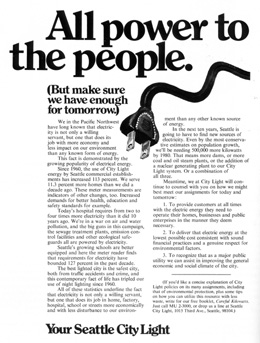On August 3, 1971, Seattle City Light increases electric rates for the first time since 1920. Seattle consumers still pay less than a penny per kilowatt-hour for their electricity, much less than the rest of the nation. The increase is the first of many over the next three decades in response to inflation and the need to limit electricity usage.
Seattle owed its low rates to the fact that the electric utility was municipally owned and that it owned its sources of power, four large dams on the Skagit and Pend Oreille rivers. City Light aggressively promoted usage, which was met by the construction of new dams.
But rising expenses due to inflation during the 1960s threatened a deficit and City Light applied to the city council for an 11 percent rate hike. The city council approved 7 percent and City Light embarked on a cost-cutting program. By July 1973, demand began to outstrip supply and City Light instituted its "Kill-a-Watt" conservation program. Within five months, consumption dropped 7 percent.

